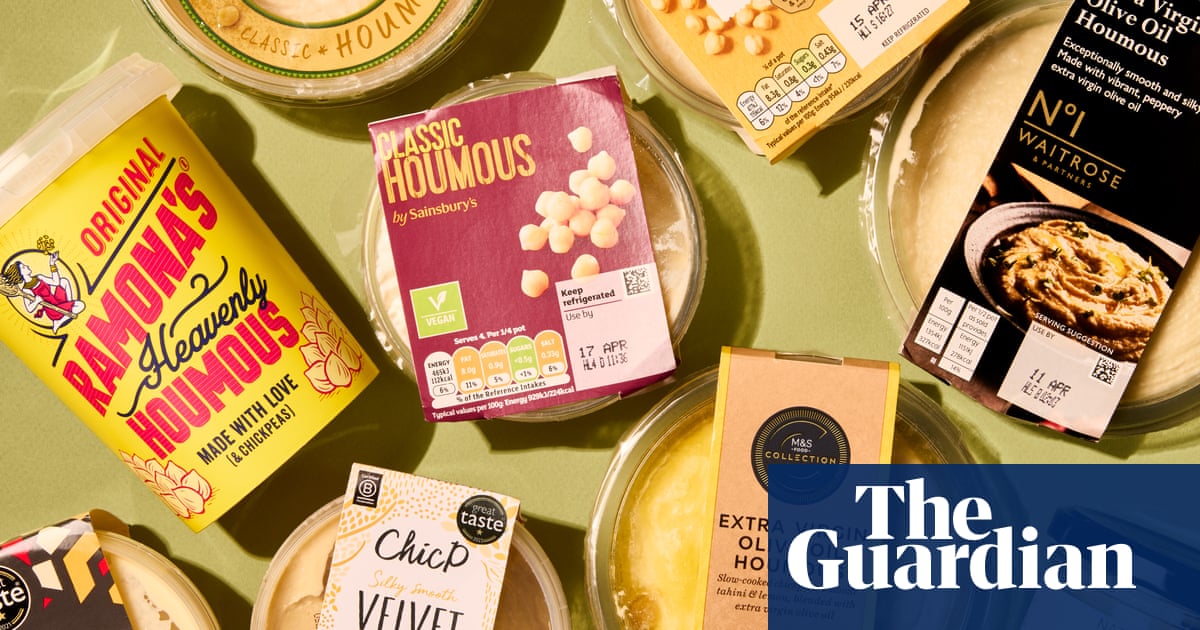Let’s start with a caveat: we have serious issues with the concept of readymade, long-shelf-life hummus. Some dips lend themselves to tub life, but for us, hummus is like bread: something that should be made fresh daily. Indeed, inour restaurants, we make a batch every day, and the tubs we sell in the deli are good for three.
We also want to challenge the idea that readymade hummus is a “healthy” snack. Freshly made with chickpeas and tahini, and seasoned with lemon, salt, garlic and maybe a little cumin, yes, hummus is wholesome. However, most of the ones we tested had added oil (olive oil in the better ones, vegetable oil in the rest), and some included preservatives and other additives, making them ultra-processed foodstuffs and decidedlynothealthy.
For most of your hummus needs, we recommend buying from a specialist or, better yet, making your own using good-quality tinnedchickpeasand tahini. It comes together in seconds and tastes far better than anything you can buy. Still, even we aren’t above a readymade dip now and then, and hummus really is the perfect companion to an office spread, a long train ride or an impromptu picnic, so we may as well know the good from the bad.
£3.50 for 500g at Tesco (70p/100g)£3.50 for 500g at Sainsbury’s (70p/100g)★★★★☆
This really tastes of chickpeas, which is great and, not surprisingly, it contains more chickpeas (66%) than any of the others tested. Not too lemony, highly seasoned, but in a good way. Quite a few additives, though.
£1.95 for 150g at Morrisons (£1.30/100g)£1.95 for 150g at Sainsbury’s (£1.30/100g)★★★★☆
A very leftfield hummus, but one we thoroughly enjoyed. The smoke comes through powerfully and pleasantly. It’s vinegary, too, which is unusual, but it works in this context. Pleasant texture and mostly natural ingredients. Great as a dip or sandwich filler.
£2.50 for 250g at Ocado (£1/100g)★★★☆☆
Smooth, easy to eat and with a resealable lid. The seasoning is balanced, but the texture is a bit greasy and fatty. It’s also loaded with oil, preservatives and additives, and has a suspiciously long shelf-life, which is not so good if you’re avoiding UPFs.
£2.75 for 170g at Waitrose (£1.62/100g)★★★☆☆
The packaging is good and easy to open. It’s not resealable, but the quantity is suited to a single sitting. The texture is grainy, the seasoning heavily citric, and the oil makes it claggy and almost too rich. Still, this is pretty decent stuff, with no preservatives or additives and all-natural ingredients.
Sign up toThe Filter
Get the best shopping advice from the Filter team straight to your inbox. The Guardian’s journalism is independent. We will earn a commission if you buy something through an affiliate link.
after newsletter promotion
£3 for 170g at Ocado (£1.76/100g)★★★☆☆
The texture is aerated in an unpleasant way, and it has a claggy mouthfeel and a heavily citric, almost metallic flavour. The chickpeas on top looked like a nice touch, but they were undercooked.
£2.65 for 250g at Tesco (£1.06/100g)£2.65 for 250g at Ocado (£1.06/100g)★★★☆☆
This tastes so much like the Sabra one that we thought it might be made by the same manufacturer. A close inspection of the packet confirmed our suspicions (see above for verdict), and we felt very proud of our palates.
£2.95 for 185g at Waitrose (£1.59/100g)£3.95 for 185g at Ocado (£2.14/100g)★★★☆☆
We really wanted to enjoy this one, but couldn’t. The glass jar is classy, but there was a weird, watery residue on top. The texture’s oddly bouncy (not unlike grout), and the flavour is what you’d imagine grout tastes like. That said, bar the citric acid, it’s all natural.
99p for 200g at Sainsbury’s (50p/100g)☆☆☆☆☆
Appealing container in a paper sleeve, but that’s where the positives end. Vile on every level: looks like thin glue (it’s split and congealed), the chickpeas are chalky, gravelly and undercooked, and have an aftertaste that lingers in a way that makes you want to brush your teeth for ever. Avoid at all costs.
99p for 200g at Tesco (50p/100g)☆☆☆☆☆
Tastes exactly like the Sainsbury’s version, and we suspect it’s made using the same misguided recipe by the same manufacturer. If that’s the case, they should be tracked down and reported.
